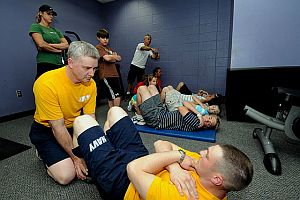Practicing sit-ups is a great way to help strengthen your core muscles, the ones that help you maintain good posture and allow you to bend and twist. If these muscles are weak, it can lead to chronic back pain and disability. But contrary to what those late-night TV ads tell you, sit-ups (whether using a machine or doing them the traditional way) will not give you a flat stomach and six-pack abs. The toned abdominal muscles will develop beneath the layer of abdominal fat, but no matter how many sit-ups you do, it will not spot reduce the amount of fat around your waist. The only thing that will remove the spare tire around your middle is a healthy diet and getting sufficient overall exercise. Once you have slimmed down overall, then those six-pack abs will show if you practice some sit-ups every day. But keep in mind that it’s important to do sit-ups properly in order to develop the optimal muscle conditioning while ensuring you do not hurt your back and neck in the process. Following are 5 tips to better sit-ups.
1) Make sure your legs are bent at a 90° angle – This is the best angle to help reduce excess stress to the lower back while you are performing a sit-up. You should be sure to do your sit-ups on a cushioned surface such as a mat or carpet. With your legs bent, there should still be just enough of a curve in your lower back so it does not touch the floor.
2) Cross your arms over your chest – The traditional hands behind the neck posture for sit-ups sometimes causes people to pull on the neck during the upward movement, which can overstretch it and cause neck pain. Instead, cross your arms over your chest and tighten your abdominal muscles to slowly lift your head and upper body off the floor.
3) Lift up only 6 to 10 inches off the floor – There is no need to sit all the way up when doing sit-ups. In fact, according to researchers at the University of Louisville, once you are above a certain angle, different muscles than the abdominals are being worked, so much of that extra effort to condition your abs is in vain.
4) Go slowly, both up and down – Many people slowly raise themselves up, then flop back down. The best workout for your abs is to go slowly, both on the way up and on the way down. This engages the abdominal muscles more fully and is more important than the number of reps you can do.
5) Pace yourself – It is common to start off doing sit-ups quickly, then slow down as your abdominals tire. Start out at a slow, steady pace, and you are more likely to be able to keep it up than if you get burned out early on in your reps.

